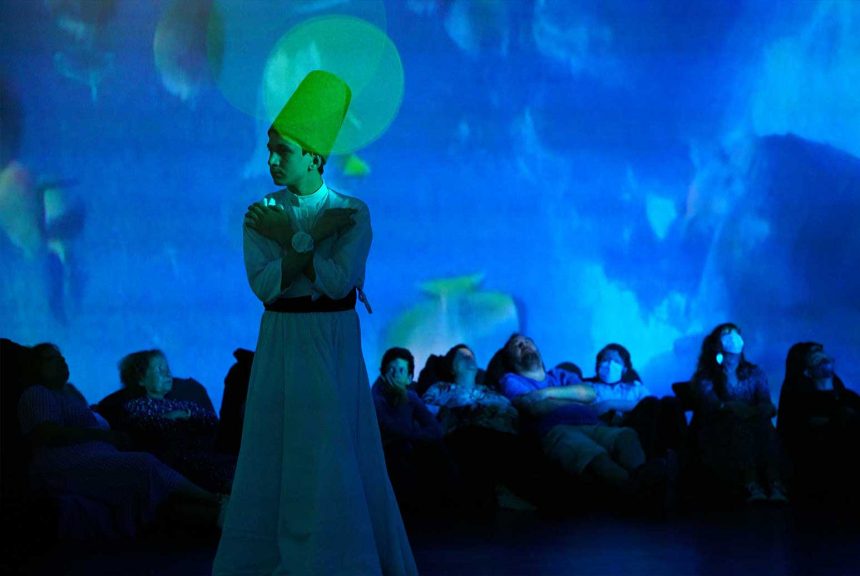Review of Digital Dervish + Flamenco Sonic
A prolonged opening section with lovely warm sounds induces a meditative state, setting up an inner experience of the production that was profound and very real. The mirror visuals of street scenes during this opening seemed at times to create the illusion of water and reflections, images that are very much a part of Above-Below, Outer-Inner, Matter-Spirit references to an inner life and the world of Spirit, in which water is often a transition zone (cf. Escher, The BFG). I wasn’t sure how the movement through urban streetscapes fit in with this and perhaps something might have been done to clarify its role but my experience throughout the production was of an inner quiet induced by the centring, balanced rotational movement expressed via the Dervish, the Flamenco dancer, the mirror visuals and Hedy’s soundtrack with its repetitive motifs. This centring is a universal theme expressed in many other different ways as well, such as for example by movement around a pole in Spanish riding, or by balance and rotation in many circus acts. When Mayez Rahman as the Dervish began to spin, with ethnic music clips intensifying the experience, his responsive and expertly tailored garment filled out into an open wave shape that was a perfect embodiment of the centred rotational movement. With various gestures he triggered different parts of the soundtrack via his Sound Drop device. In this way he was able to adapt the performance of the music to his movements. No doubt a heap of technical expertise made this flexibility possible.
A programme note spoke of the Dervish becoming “enveloped in a storm of chaos … collapse … eventually rising to embrace the mayhem.” I did not perceive very much in the way of chaos or embracing of mayhem and wonder if this thinking may have led to a lessening of the primary imagery and intention of the production. If the central section of the production was meant to be chaotic, this didn’t happen for me. For example, I found the hand-drawn shapes still part of an inner quiet. Even though they moved rapidly, the colours were pleasant, the shapes had curved edges, and the movement often rotational. The beauty and appropriateness of Kaz Rahman’s images, wonderfully projected onto the ceiling of the Dome included other ‘darker’ shapes which looked like underwater scenes with fish and plants (they may have been something else!) and evoked a sense of the inner world, rather than chaos — with the mirror imaging continuing.
The Flamenco dance, so expertly performed by Mercedes Romero, picks up the centred, balanced, rotational movement in its own way, and was very appropriate for the overall theme. There were castanets on the soundtrack (they sounded rather feeble — I would have preferred live castanets) and then perhaps an extension of this sound into more complex textures on the soundtrack. When the Flamenco dancer approached the Dervish, who had been ‘collapsed’ on the floor (half-sitting, not prone), he emerged from his dormancy.
These observations have focused on the centring aspect because that is what I experienced the most. The central section, I think, struck a note of profundity rather than chaos, and to bring this profundity out more may have enhanced the production. It would be quite reasonable to make the complexity of life and its chaotic elements a more prominent element of the storyline. If so, I think more would have to be done to make this perceptible (with convincing motivations) in a show that in many ways moved me very deeply: why the fast-moving urban images at the beginning- when the musical sounds were so measured and lovely (I did like them) and the Dervish was not yet active?
To summarise, I enjoyed the performance of Digital Dervish + Flamenco Sonic (Plymouth Market Hall Dome, Friday 6 May 2022) and very much appreciated the smooth running of what must have been a very technically complex show to put together. It was a great achievement, and I’ve taken away some lasting memories that I shall cherish from a marvellous and moving show with many profound resonances.
by Archer Endrich
Born in the USA, Archer is a composer of both acoustic and electroacoustic music. He migrated to the UK in 1971 and completed a Doctorate in Music Composition at the University of York. He has been Coordinator and administrator of the Composers Desktop Project (CDP) since its inception in 1987. CDP is one of the most comprehensive software tools for sound transformations and composition ever developed. He has authored most of its Reference Documentation and Tutorials. Archer is a Visiting Research Fellow at ICCMR where he conducts research into electroacoustic music composition and sound design.


Leave a Reply